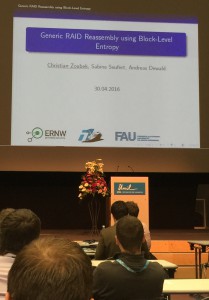In their talk “Reverse Engineering a Digital Two Way Radio” Travis Goodspeed and Christiane Ruetten presented the challenges they faced and overcame while reverse engineering “Tytera MD380”, a handheld transceiver for the Digital Mobile Radio (DMR) protocol.
“Tytera MD380” is based around two chips: STM32F405 CPU with an ARM Cortex M4F core and Readout Device Protection and a HRC5000 baseband processor which implements the actual digital radio. While STM32F405 is fully documented, there is no documentation for HRC5000 publicly available but with the help of the Chinese community they were able to obtain the Chinese documentation.
Continue reading “Reverse Engineering a Digital Two-Way Radio”
Continue reading